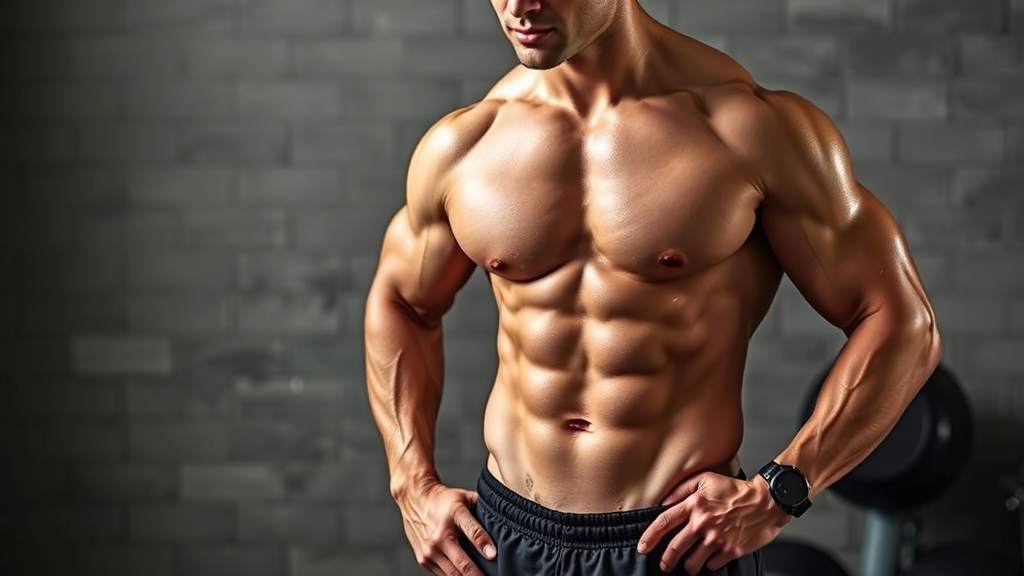Can I build muscle and lose fat at the same time?
Many people wonder if it’s possible to build muscle and lose fat simultaneously. This question often arises when following a new workout routine or diet plan. The good news is that, with the right approach, it can be done. However, it requires a clear strategy focusing on nutrition, exercise, and recovery.
Understanding Muscle Growth and Fat Loss
To build muscle, your body needs to be in a state of positive nitrogen balance, which typically occurs when you eat more calories than you burn. Conversely, to lose fat, you need to create a caloric deficit, consuming fewer calories than you expend. These opposing needs can make it seem impossible to achieve both goals at the same time.
Can You Balance Both? Yes!
The key to successfully building muscle while losing fat is finding a balance that suits your individual needs. Here are some effective strategies:
- Prioritize Strength Training: Lifting weights is essential for muscle growth. Aim for at least 3 to 4 days of strength training each week, focusing on compound movements like squats, deadlifts, and bench presses.
- Incorporate Cardiovascular Exercise: Incorporate moderate cardio sessions to help with fat loss. Consider 2 to 3 sessions a week, ranging from 20 to 30 minutes each.
- Follow a Balanced Diet: Fuel your body with the right nutrients. A diet rich in protein, healthy fats, and whole grains can help you build muscle while shedding fat. Aim for around 1.6 to 2.2 grams of protein per kilogram of body weight.
- Manage Caloric Intake: To hit the sweet spot between muscle building and fat loss, eat at maintenance calories or in a slight deficit. Avoid significant calorie cuts which can hinder muscle growth.
- Stay Hydrated: Drink plenty of water to support your metabolism and overall health. Hydration plays a vital role in muscle recovery as well.
- Get Adequate Rest: Recovery is crucial. Aim for 7 to 9 hours of quality sleep each night to aid muscle recovery and fat loss.
Choosing the Right Macros
Finding the right macronutrient ratio is crucial when trying to build muscle and lose fat. One successful approach is:
| Macronutrient | Percentage of Total Calories |
|---|---|
| Protein | 30-35% |
| Fats | 20-30% |
| Carbohydrates | 35-50% |
Adjusting these percentages can vary based on your specific body type, activity level, and metabolic needs. Tools like [MyFitnessPal](https://www.myfitnesspal.com) can assist in tracking your macros effectively.
Importance of Progressive Overload
To build muscle effectively, it’s important to apply the principle of progressive overload. This means gradually increasing the weight or resistance you use in your workouts. This constant challenge leads to muscle adaptation and growth.
The Role of Supplements
While supplements should not replace whole foods, certain products can support your goals. Consider the following:
- Protein Supplements: A high-quality protein powder can help you meet your daily protein goals.
- Creatine: This supplement has been shown to enhance muscle strength and recovery.
- Branched-Chain Amino Acids (BCAAs): These can aid muscle recovery post-workout.
Before adding any supplements to your regimen, consult a healthcare professional or a certified nutritionist to tailor the right options for your needs.
While building muscle and losing fat at the same time may seem challenging, it is completely achievable with the right combination of strategies. Focus on nutrition, engage in regular strength training, and ensure you maintain a balanced approach to your workouts and recovery. By following these guidelines, you will be well on your way to reaching your fitness goals.
For more in-depth knowledge about muscle building and fat loss, check out resources on [Bodybuilding.com](https://www.bodybuilding.com) and [Examine.com](https://examine.com) which can provide evidence-based insights and guidance.
The science behind muscle growth and fat loss
Muscle growth and fat loss are two goals many fitness enthusiasts strive to achieve. Understanding the science behind these processes can significantly influence your workout and dietary choices. Let’s break down the essential concepts involved in building muscle while losing fat.
The Role of Protein in Muscle Growth
Protein is crucial for muscle growth. When you engage in resistance training, you create small tears in your muscle fibers. Your body repairs these tears through a combination of amino acids from the protein you consume, leading to increased muscle size and strength. Here are key points to consider:
- Daily Protein Intake: Aim for around 0.7 to 1 gram of protein per pound of body weight.
- Protein Timing: Distributing protein intake throughout the day can maximize muscle protein synthesis.
- High-Quality Sources: Opt for lean meats, fish, eggs, dairy, legumes, and plant-based proteins.
Understanding Caloric Balance
To lose fat, you need to create a caloric deficit. However, this must be balanced to ensure you do not compromise muscle growth. Here’s how you can achieve that:
- Calculate Maintenance Calories: Use a calorie calculator to find out how many calories your body needs to maintain its current weight.
- Create a Moderate Deficit: Aim for a caloric deficit of 300-500 calories per day for safe fat loss without impacting muscle growth.
- Monitor Adjustments: Keep track of your weight and adjust your intake and exercise accordingly.
Resistance Training vs. Cardio
Both resistance training and cardiovascular exercise play essential roles in achieving your fitness goals. Each type of exercise has unique benefits:
| Type of Exercise | Benefits for Muscle Growth | Benefits for Fat Loss |
|---|---|---|
| Resistance Training | Builds muscle mass and strength | Boosts metabolism |
| Cardio | Helps with recovery and heart health | Burns calories and aids in fat loss |
By incorporating both forms of exercise into your routine, you maximize the benefits for both muscle growth and fat loss.
The Impact of Hormones
Hormones play a significant role in regulating muscle growth and fat loss. Some key hormones to consider include:
- Testosterone: Promotes muscle growth and fat loss. Resistance training helps boost testosterone levels.
- Insulin: Plays a role in nutrient storage. Managing your carbohydrate intake helps keep insulin levels stable.
- Growth Hormone: Aids in muscle repair and fat metabolism. High-intensity workouts can stimulate its release.
Nutrition’s Role in Recovery
A proper diet supports recovery, allowing for effective muscle growth and fat loss. Key nutrition strategies include:
- Post-Workout Nutrition: Consume a mix of protein and carbohydrates within 30 minutes after your workout to support recovery.
- Healthy Fats: Include sources like avocados, nuts, and olive oil to support overall health without compromising performance.
- Hydration: Drink enough water throughout the day to support metabolic processes and optimize athletic performance.
To learn more about specific frameworks and dietary plans that enhance muscle growth and fat loss, consider exploring reputable resources like Bodybuilding.com and ACSM’s position stands. These websites provide valuable insights into the nuances of training and diet.
Building muscle while losing fat is a delicate balance that requires the right approach to protein intake, caloric balance, exercise, hormones, and recovery. By focusing on these areas, you can achieve your fitness goals more effectively.
Nutritional balance: Finding the right diet for dual goals
When it comes to fitness, many people aim to build muscle and lose fat simultaneously. This dual goal often seems challenging, but it is entirely possible with the right approach to nutrition and training. Finding the right diet is crucial for achieving both muscle gain and fat loss. In this article, we will explore effective dietary strategies and considerations that can help you achieve both goals.
Your dietary choices play a significant role in how well you can build muscle and lose fat. A balanced nutritional plan focuses on macronutrients: proteins, carbohydrates, and fats. Here’s how to strike the right balance:
Understanding Macronutrients
To support muscle growth while losing fat, it’s essential to understand the role of each macronutrient:
- Protein: This is vital for muscle repair and growth. Aim for a protein intake of around 1.6 to 2.2 grams per kilogram of body weight. Good sources include lean meats, poultry, fish, eggs, dairy, legumes, and plant-based protein powders.
- Carbohydrates: Carbs are your body’s primary energy source, necessary for fueling workouts. Choose complex carbs like whole grains, fruits, and vegetables. Depending on your activity level, 45-65% of your daily calories should come from carbohydrates.
- Fats: Healthy fats support hormone production and overall health. Focus on sources like avocados, nuts, seeds, and olive oil. Aim for fats to make up 20-35% of your daily caloric intake.
Caloric Balance
A caloric deficit is usually needed for fat loss, while a caloric surplus is often required for muscle gain. This might seem conflicting, but you can implement a strategic approach:
If your goal is to build muscle while losing fat, you want to achieve a slight caloric deficit or maintain your weight. This approach helps ensure your body has enough energy to grow muscle while using stored fat for energy. Here are some tips:
- Calculate Your Needs: Use a calorie calculator to determine your daily energy expenditure and macronutrient ratios. Websites like MyFitnessPal can assist with tracking your intake.
- Focus on Meal Timing: Consuming protein-rich meals and snacks before and after workouts can maximize muscle repair and growth. This habit also aids in effective fat loss.
- Hydrate: Water plays a crucial role in overall health and can impact muscle performance. Aim for at least 8-10 cups of water daily.
Food Choices Matter
While macronutrient distribution is vital, the quality of your food choices matters too. Opt for whole foods that provide essential vitamins and minerals:
- Lean meats and fish for protein
- Whole grains for sustained energy
- Fruits and vegetables for fiber and nutrients
- Legumes and nuts for plant-based proteins and healthy fats
Be sure to limit processed foods, added sugars, and excessive saturated fats. These foods can hinder your efforts, making it harder to build muscle and lose fat.
Supplements and Nutrition
Some individuals may benefit from dietary supplements to reach their dual goals more efficiently. Consider the following:
Whey protein, creatine, and branched-chain amino acids (BCAAs) can support muscle gain. However, it’s essential to remember that supplements should complement your diet, not replace whole foods. Always consult with a healthcare provider before adding supplementation to your routine.
Consistency is Key
Consistency is crucial when pursuing muscle gain and fat loss. Establishing a meal plan and sticking to it over time will yield the best results. Consider preparing meals in advance to avoid options that may derail your progress. Tracking your food intake through apps or journals can also help you stay accountable.
Achieving both muscle gain and fat loss is not an overnight process. Patience and persistence are necessary. For additional information on nutrition and fitness strategies, check out resources like Precision Nutrition and Bodybuilding.com.
The right diet, focusing on balanced macronutrients, caloric balance, food quality, and consistency, can help you achieve the ambitious goal of building muscle while losing fat. By following these guidelines, you’re taking positive steps toward reaching your fitness goals.
Exercise strategies for building muscle while shedding fat
When it comes to changing your body composition by building muscle while shedding fat, understanding effective exercise strategies is crucial. Many people wonder if it’s possible to achieve both goals simultaneously. The answer is yes, but it requires a focused approach. Here are some strategies to guide you in your journey.
Incorporate Strength Training
Strength training is vital for building muscle. Aim to include compound movements in your workouts, which target multiple muscle groups simultaneously. Here are some essential exercises:
- Squats
- Deadlifts
- Bench Press
- Pull-Ups
- Rows
Performing these exercises two to four times a week can stimulate muscle growth effectively. Pay attention to the weight and gradually increase it to challenge your muscles.
Don’t Skip Cardio
While strength training builds muscle, cardiovascular exercise helps burn fat. Incorporate high-intensity interval training (HIIT) into your routine. HIIT involves short bursts of intense activity followed by rest periods. You might consider:
- Sprint intervals
- Cycling sprints
- Bodyweight circuit training
Engaging in cardio three times a week for 20-30 minutes can keep your heart healthy and support fat loss.
Focus on Nutrition
Your diet plays a crucial role in building muscle and losing fat. Here are essential nutritional tips:
- Protein Intake: Consume at least 0.8 to 1 gram of protein per pound of body weight. Sources include lean meats, fish, dairy, beans, and legumes.
- Healthy Fats: Include healthy fats in your diet like avocados, nuts, seeds, and olive oil.
- Complex Carbohydrates: Opt for whole grains, fruits, and vegetables to fuel your workouts.
- Hydration: Drink plenty of water to stay hydrated, especially during intense workouts.
A balanced diet tailored to your energy needs will support your goals immensely.
Implement Active Recovery
Recovery is just as important as exercise. Incorporate active recovery days where you engage in light activities such as walking, yoga, or swimming. This promotes muscle repair without completely resting your body and can support fat loss.
Monitor Your Progress
Track your workouts and nutrition to identify what works best for you. Consider keeping a journal or using apps to log your exercises and meals. Assess your progress every few weeks; you should see improvements in strength and body composition if you’re following your plan effectively.
Be Patient and Consistent
Building muscle while losing fat takes time. Set realistic goals and be consistent in your efforts. Understand that some weeks might show more progress in one area than the other, but that’s perfectly normal. The combination of lean muscle gain and fat loss will occur eventually with sustained effort.
Helpful Resources
If you’re looking for more tips and structured workout plans, consider visiting these sites:
- Bodybuilding.com – Great for workout routines and nutrition advice.
- Healthline Nutrition – Offers insights into dietary strategies for muscle gain and fat loss.
- Muscle & Strength – Resources for fitness training and muscle-building guidance.
Strength training, cardio, proper nutrition, active recovery, and a consistent approach will place you well on the path to achieving your fitness goals. The journey might be challenging, but remember that each step brings you closer to a healthier, fitter you. Stay committed, and you’ll see results!
The role of strength training in body composition
In the journey toward a healthier body, strength training plays a crucial role, particularly when it comes to body composition. Many people engage in workouts to primarily lose weight, but often overlook the importance of building muscle. Strength training not only helps in burning calories but also plays a vital role in improving overall body composition by altering the balance between fat and lean mass.
When you engage in strength training, the primary goal is typically to increase muscle mass. This has a significant effect on your metabolism and how your body processes energy. Muscle tissue burns more calories at rest compared to fat tissue, which means that more muscle can lead to a higher resting metabolic rate. This is a key factor if you’re looking to lose fat while preserving or enhancing muscle mass.
One important aspect to understand is how strength training assists with fat loss. It helps create a caloric deficit, where you burn more calories than you consume. Here’s how:
- Increased muscle mass: As mentioned earlier, more muscle equates to burning more calories, even when you’re not exercising.
- Afterburn effect: Strength training boosts your metabolism even after your workout ends. This phenomenon, known as excess post-exercise oxygen consumption (EPOC), means you continue to burn calories long after you’ve finished lifting weights.
- Improved insulin sensitivity: Regular strength training increases insulin sensitivity, which helps your body utilize carbohydrates and fats more efficiently.
Now, let’s consider how strength training can shift your body composition:
| Body Composition Change | Effects of Strength Training |
|---|---|
| Increase in Muscle Mass | Improves metabolic rate and calorie burning. |
| Decrease in Fat Mass | Aids in fat loss while maintaining muscle. |
| Improved Muscle Definition | Creates a leaner physique, enhancing aesthetics. |
| Bone Density | Strength training promotes stronger bones, lowering injury risk. |
Another critical factor in the relationship between strength training and body composition is nutrition. You may find that to optimize your body composition, your diet needs to support your training goals. Here are some nutrition tips:
- Protein intake: Consuming adequate protein is essential for muscle repair and growth. Aim for around 1.6 to 2.2 grams of protein per kilogram of body weight.
- Balanced diet: Ensure you’re getting enough carbohydrates and healthy fats to fuel your workouts and aid recovery.
- Hydration: Staying well-hydrated also supports muscle function and performance.
A structured strength training program into your routine is a game changer. It’s not just about lifting weights; it’s about creating a sustainable habit that supports your overall health. Aim to include a combination of:
- Compound exercises: Movements like squats, deadlifts, and bench presses engage multiple muscle groups.
- Progressive overload: Gradually increase weight or resistance over time to challenge your muscles further.
- Consistency: Stick with your training regimen for the long haul for lasting results.
While strength training is vital for changing your body composition, it’s essential to remember that every individual’s response can vary. Factors such as genetics, age, and overall fitness level can influence your results. Therefore, monitor your progress closely and make adjustments to your training and nutrition as necessary.
If you want to delve deeper into strategies that can enhance your workouts and boost body composition changes, consider visiting resources like Bodybuilding.com or NASM for expert insights and advice.
Strength training is not just for bodybuilders or athletes; it’s a powerful tool that anyone can use to improve their health and body composition. Remember, the key is to approach your training with the right mindset and nutritional support, ensuring that you not only lose fat but also build and maintain muscle for a healthier, fitter you.
Common myths about simultaneous muscle gain and fat loss
When it comes to fitness goals, many people wonder if they can build muscle and lose fat at the same time. This concept has sparked numerous discussions and has led to the rise of several myths. It is essential to differentiate facts from fiction, as understanding these myths can lead to more effective workout routines and dietary strategies.
One common myth is that you cannot build muscle and lose fat concurrently. Many believe that you must choose one goal over the other. However, individuals who are new to exercise or returning after a long break may experience both fat loss and muscle gain simultaneously, thanks to the body’s adaptive nature. In fact, research shows that a proper combination of resistance training and a slight caloric deficit can lead to these twin goals.
Another misconception is that you need to eat a high-protein diet exclusively to gain muscle. While protein is important for muscle repair and growth, a well-balanced diet that includes healthy fats and carbohydrates is also critical. Carbohydrates provide the energy necessary for intense workouts, while healthy fats assist with hormone production and overall health. Thus, an extreme focus solely on protein can lead to nutrient deficiencies which may hinder your progress.
Many people think that lifting heavy weights is the only way to build muscle. While it is true that progressive overload is essential, it is not the sole method. Various forms of resistance training, including bodyweight exercises, light weights, and increased repetitions, can be effective in building muscle. Varying your workout routine keeps your body challenged and engaged, leading to better results.
A frequent mistake is assuming that cardio hinders muscle growth. While excessive cardio can contribute to muscle loss, incorporating moderate cardio into your routine can actually help in fat loss. The key is to strike a balance. For example, consider using High-Intensity Interval Training (HIIT), which not only burns fat but also preserves muscle mass effectively.
There is a prevalent myth that weight loss means cutting calories drastically. This can lead to muscle loss rather than fat loss. Instead, aim for a moderate caloric deficit. A safe and sustainable approach typically involves reducing caloric intake by about 500 calories per day, coupled with regular exercise. This strategy allows you to gradually lose fat while still providing your body with the necessary nutrients to build muscle.
Consider the following table summarizing the myths and truths surrounding simultaneous muscle gain and fat loss:
| Myth | Truth |
|---|---|
| You can’t build muscle and lose fat at the same time. | Beginners can often experience both due to a stronger adaptive response. |
| High protein diets are the only way to gain muscle. | A balanced diet including carbs and fats is essential for overall health and performance. |
| You must lift heavy weights to build muscle. | Different resistance training methods can also promote muscle growth. |
| Cardio will hinder muscle growth. | Moderate cardio helps with fat loss and can preserve muscle when balanced with strength training. |
| Cuts in calories must be extreme for fat loss. | A moderate caloric deficit of 500 calories is more effective and healthier. |
Understanding the myths surrounding muscle gain and fat loss is key to achieving your fitness goals. Are you interested in learning more about simultaneous training for muscle and fat loss? You can find valuable tips and research articles at Bodybuilding.com or follow the latest scientific findings at NCBI.
Combining muscle gain with fat loss can be tricky, but it’s possible with the right program and mindset. By acknowledging the myths and focusing on evidence-based strategies, you can create a balanced fitness plan that accommodates your goals successfully.
The importance of recovery and sleep in achieving fitness goals
When pursuing fitness goals, many people focus on exercise and nutrition while neglecting two crucial elements: recovery and sleep. Without proper recovery and adequate sleep, your body may struggle to perform at its best, which can halt progress toward your fitness aspirations.
Why Recovery Matters
Recovery is the body’s way of repairing itself after strenuous workouts. Here’s why it plays such a vital role:
- Muscle Repair: During intense exercise, tiny tears occur in your muscles. Recovery allows these muscles to heal and grow stronger.
- Preventing Injury: Continuous training without adequate recovery increases the risk of injuries. Giving your body time to recover helps to avoid strains and sprains.
- Improved Performance: A well-recovered body performs better. You can lift more weight, run faster, and push yourself harder when your body is ready.
- Mental Wellness: Recovery isn’t just physical. Taking time to rest helps improve your mental focus and motivation.
The Role of Sleep in Fitness
Sleep is another pillar of fitness that is often overlooked. It is during sleep that the body goes through vital processes that help you achieve your fitness goals:
- Hormonal Balance: Sleep helps regulate hormones that control appetite and metabolism, such as ghrelin and leptin.
- Energy Restoration: Your body replenishes lost energy during sleep, which is essential for high-performance workouts.
- Cognitive Function: Enough sleep enhances your cognitive abilities, allowing you to stay focused during workouts and decision-making regarding food intake.
- Immune Function: Quality sleep boosts your immune system, making it less likely for you to fall ill and miss workouts.
How Much Recovery and Sleep Do You Need?
Understanding recovery and sleep needs can help tailor your fitness regimen. Here are some guidelines:
| Activity Level | Recovery Time (Days) | Recommended Sleep (Hours) |
|---|---|---|
| Light Exercise (Walking, Yoga) | 1-2 | 7-8 |
| Moderate Exercise (Weight Training, Running) | 2-3 | 7-9 |
| Intense Exercise (Competitive Sports, High-Intensity Training) | 3-5 | 8-10 |
Practical Tips for Better Recovery and Sleep
Implementing strategies can help enhance your recovery and improve your sleep quality. Here are some practical tips:
- Stay Hydrated: Drink fluids before, during, and after workouts to support recovery.
- Nutrition Matters: Focus on consuming proteins and healthy fats post-workout to facilitate muscle repair.
- Stretch and Foam Roll: Incorporate stretching and foam rolling into your routine to reduce muscle tension.
- Create a Sleep Schedule: Go to bed and wake up at the same time every day to regulate your body clock.
- Limit Screen Time: Avoid screens for at least an hour before bed to improve sleep quality.
- Create a Comfortable Sleep Environment: Ensure your bedroom is dark, quiet, and cool to promote restful sleep.
Balancing recovery and sleep with your fitness goals is essential. Prioritizing these aspects will not only enhance your performance but also speed up your progress. For more tips on sleep and recovery, consider visiting The Sleep Foundation or ACE Fitness.
Remember, fitness is a journey that requires proper attention to recovery and rest. By respecting and addressing these key elements, you’re setting yourself up for long-term success in achieving your fitness goals.
Key Takeaway:
When considering the question, "Can I build muscle and lose fat at the same time?" the answer is a nuanced yes, but it involves understanding a balance of science, nutrition, exercise, and recovery. First and foremost, it’s essential to grasp the scientific principles of how muscle grows and fat is lost. Muscle growth happens when you engage in resistance training, which creates micro-tears in muscle fibers that are repaired stronger during recovery. Fat loss, on the other hand, requires a caloric deficit—burning more calories than you consume.
For those wishing to achieve both goals simultaneously, finding the right nutritional balance is crucial. It’s not just about eating less; it’s about eating smart. Consuming a diet rich in protein aids in muscle repair and growth while also helping to keep you satiated, reducing the urge to snack on unhealthy foods. Healthy fats and carbohydrates are also vital—they provide energy for workouts, allowing you to push harder in the gym, which can help in muscle retention while you lose fat.
The right exercise strategies is equally necessary. Strength training forms the backbone of a dual goal program, as it stimulates muscle growth even when on a caloric deficit. Including both compound movements and high-intensity interval training (HIIT) can boost your metabolism and maximize fat loss, making them effective tools for changing your body composition.
Still, it’s important to dispel common myths that suggest you can’t build muscle while losing fat. Many believe these two processes are mutually exclusive, but science shows they can coexist under the right conditions. Recovery and sleep also play pivotal roles in achieving fitness goals. Quality sleep aids in muscle repair and can improve your metabolic function, which is crucial when you’re trying to lose fat.
Ultimately, if you’re looking to build muscle and lose fat at the same time, remember that consistency, smart nutrition, strength training, and ample recovery are your best strategies. This balanced approach will set you up for success in achieving a healthier, stronger body.
Conclusion
Achieving the dual goals of building muscle and losing fat is not just a dream; it’s a realistic possibility with the right approach. Understanding the science behind muscle growth and fat loss is foundational. By leveraging nutritional balance, you can fuel your body with the right nutrients, ensuring that your diet supports both muscle development and fat reduction.
Effective exercise strategies is paramount. Utilizing strength training not only contributes to muscle gain but also enhances your metabolism, which can aid in fat loss. Yet, it is crucial to debunk common myths surrounding these goals; you don’t have to choose one over the other. Many people believe that focusing on one will sabotage the other, but with proper planning, you can navigate this balance successfully.
Equally important is recognizing the role of recovery and quality sleep in your regimen. Muscle repair happens during rest, and without adequate recovery, progress can stall. Prioritizing sleep can enhance your energy levels and hormone balance, both of which are essential for achieving your fitness aspirations.
By aligning your nutrition, exercise, and recovery strategies, you can effectively create a body composition that reflects your hard work. Each element plays a vital role, and when they work in harmony, you set yourself up for success in your journey to build muscle and lose fat simultaneously. Embrace this holistic approach to enhance not just your body, but your overall health and well-being.







Leave a Reply